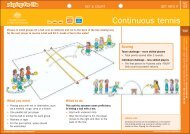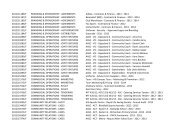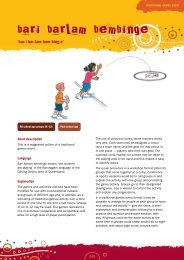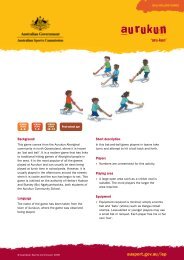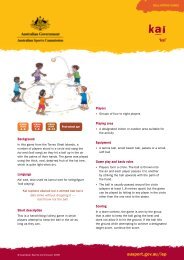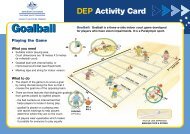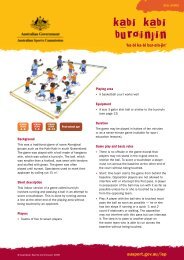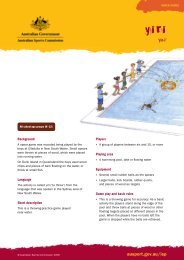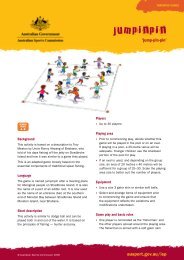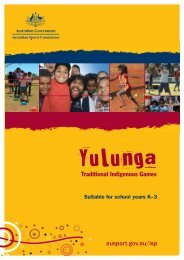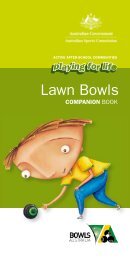the sydney 2000 olympic and paralympic games - Australian Sports ...
the sydney 2000 olympic and paralympic games - Australian Sports ...
the sydney 2000 olympic and paralympic games - Australian Sports ...
You also want an ePaper? Increase the reach of your titles
YUMPU automatically turns print PDFs into web optimized ePapers that Google loves.
PART FOUR : NSW GOVERNMENT AGENCIES GAMES SUPPORT SERVICES<br />
• The management of 2,200 Olympic cars that transported IOC <strong>and</strong> National Olympic Committee<br />
members <strong>and</strong> o<strong>the</strong>r associates of international sporting federations. This was part of a wider Olympic<br />
Games fleet.<br />
• The acquisition <strong>and</strong>/or operation of 197 separate sites (in conjunction with OCA), including <strong>the</strong><br />
37 hectare 1,000 bus Olympic Family depot at Regents Park, a 550 bus depot in R<strong>and</strong>wick <strong>and</strong> a 300<br />
bus depot at Greystanes, 73 bus layover areas, 9 car fleet depots <strong>and</strong> 32 spectator Park <strong>and</strong><br />
Ride Sites.<br />
Games Planning<br />
A key objective of Games transport planning was to achieve public acceptance of public transport as a<br />
means to access major events. This was successfully achieved with record numbers of people using <strong>the</strong><br />
Sydney public transport network <strong>and</strong> high levels of customer satisfaction with <strong>the</strong> service provided.<br />
In terms of transport planning <strong>and</strong> logistics, <strong>the</strong> Olympics was a unique event. Meeting <strong>the</strong> dem<strong>and</strong>s of <strong>the</strong><br />
Games involved addressing <strong>the</strong> complex travel patterns of athletes, officials, spectators, media <strong>and</strong> <strong>the</strong><br />
Olympic Family. Key issues included <strong>the</strong> development of Olympic timetables to accommodate Gamestime,<br />
including <strong>the</strong> significant task of determining workable bus routes to meet complex <strong>and</strong> dynamic<br />
travel patterns.<br />
Test Events<br />
Preparations for <strong>the</strong> Games included a series of test events aimed at allowing ORTA to trial <strong>and</strong><br />
progressively improve <strong>the</strong> Olympic transport system. There were 3.9 million passenger trips to Sydney<br />
Olympic Park (SOP) in <strong>the</strong>se test events. While not of <strong>the</strong> size of <strong>the</strong> Olympic <strong>and</strong> Paralympic Games, <strong>the</strong>y<br />
were extremely valuable to <strong>the</strong> development of Games arrangements for all transport agencies.<br />
The first Olympic test event was <strong>the</strong> 1998 Royal Easter Show. ORTA initiated a massive campaign to<br />
promote <strong>the</strong> public transport system to Homebush Bay. The outcome was successful with more than 85%<br />
of Show visitors using public transport.<br />
ORTA also gained valuable venue experience through SOCOG test events such as <strong>the</strong> 1999 Rugby<br />
League Gr<strong>and</strong> Final, hockey, h<strong>and</strong>ball <strong>and</strong> archery events, which were all held at SOP on <strong>the</strong> one day.<br />
This was <strong>the</strong> first time crowds had traveled to 4 SOP venues on one day. The combined events tested<br />
comm<strong>and</strong> <strong>and</strong> control mechanisms, vehicle permit arrangements, road management, air transport for<br />
athletes <strong>and</strong> officials, community consultation <strong>and</strong> interaction with o<strong>the</strong>r venue staff.<br />
Transport Tickets<br />
Olympic travel entitlements were included in every spectator ticket to ensure <strong>the</strong> most efficient <strong>and</strong><br />
effective movement of people during <strong>the</strong> Games. The free spectator travel applied to <strong>the</strong> entire CityRail<br />
network <strong>and</strong> Olympic buses, <strong>and</strong> could also be used for non-competition purposes. Volunteers were also<br />
entitled to free travel on ferries <strong>and</strong> STA <strong>and</strong> private buses.<br />
Communication<br />
ORTA provided ongoing Games information to <strong>the</strong> public, including media releases, advertisements <strong>and</strong><br />
<strong>the</strong> ORTA website. Communication campaigns were used to inform residents <strong>and</strong> businesses of Olympic<br />
transport plans, <strong>and</strong> to encourage changes to daily travel patterns during <strong>the</strong> Games, such as working<br />
from home.<br />
As part of <strong>the</strong> Sydney <strong>2000</strong> Communications Group, ORTA made major contributions to <strong>the</strong> Sydney <strong>2000</strong><br />
Official Spectator Guide. The Spectator Guide provided recommended travel routes for spectators,<br />
50



